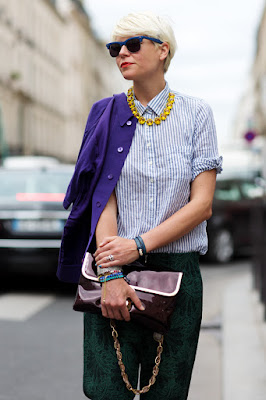That's Schuman above. He used to work in fashion but left to record how ordinary consumers interpret what's offered in the stores. He sees it as the street talking back to the industry. Wow! What an interesting idea!
This (above) is my favorite of all the pictures in the book because it emphasizes the timeless appeal of shape and cut above color and graphic design. The color's great though, no doubt about it.
Vests are still in style for men.
Geez, the problem with all these designs is that they're meant for trim people with good physiques.
It's their reward for all the time spent walking to nowhere on treadmills and eating tasteless salads.
Schuman also devotes time to what he calls "curvy" people, but many of the pictures fail to excite. Let's be honest. Fashion is a thin person's sport.
It does have one unexpected asset, though. It can look almost as good on old people as the young.
Who'da thunk that nature would take pity on you at an age when you're watching endless re-runs of "Murder, She Wrote?"
This woman isn't old but she has white hair which is taken to be a sign of age, but which can look great.
I like the colors she's wearing: green, purple and yellow with blue and white stripes used as a neutral to set it off. It's a color scheme discovered by David Hockney.
I used to think of neutrals as grey and brown but really, they're anything that most other colors look good on top of.




















































